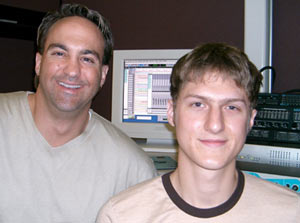Universal Audio WebZine
Volume 2, Number 8, September 2004
[UA Universe] [Ask the Doctors] [Digital Discourse] [Analog Obsession]
[Support Report] [The Channel] [Digi-Talk] [Analog Dialog] [Featured Promotion]
[Graphic-Rich WebZine]
[Back Issues] [UA Home]
 |
|
Randy and Jor
|
Support Report: Choosing the right motherboard when building a PC UAD-1 DAW
Single or Dual CPU system
One of the first considerations of workstation users today is whether to go Single- or Dual-CPU. Both systems are compatible with the UAD-1 and each has their pros and cons. Your basic considerations should be your budget and need for real-time performance.
Single CPU systems are more cost-effective and offer better real-time performance. Dual systems are significantly more expensive to build, but have more processing capacity, and often feature excellent stability and scalability. Due to the shared-memory architecture of today's dual systems, performance is inherently adversely affected. Also, the dual system market speeds are consistently a step behind single systems.
Take into consideration your demands for the system and whether your software is compatible and optimized for dual CPUs. The difference in processing capabilities is sometimes not worth the difference in price or compatibility issues.
Some examples of typical usage scenarios
- Single
- Musician/Project studio
- Soft-synths
- MIDI
- Sequencing
- Real-time monitoring
- Lower host plug-in count
- Lower track count
- Lower latency
- Musician/Project studio
- Dual
- Recording/Editing Studio
- Mastering studio
- Batch Processing
- Higher host plug-in count
- Higher track count
- Higher latency
- Recording/Editing Studio
Single-CPU consumer gaming or business PCs, and high-end, dual-CPU servers are not good systems to use for audio workstations. Look for the keyword "workstation" when considering motherboard options.
CPU
Buy the fastest CPU(s) within your budget. All current CPU technologies are supported:
- Intel
- Pentium 4
- P4 HT
- P4 EE
- Xeon
- AMD
- Athlon XP
- Athlon MP
- Athlon 64
- Athlon 64 FX
- Opteron
If you're considering an Opteron system, look for systems using the VIA and nVidia chipsets, not AMD.)
Memory
The fastest memory technology available today is DDR and the upcoming DDR2.
Aim for the fastest Front Side Bus (FSB) / Memory speed as possible! This is the primary bottleneck of an audio system. The faster your speeds and bandwidth, the better the performance. Adding a lot of slow RAM to your system will do nothing to increase performance, you're better off with 512MB of fast RAM than 1GB of slow RAM. When purchasing, make sure that all of your components are capable of the same high speeds. e.g. Motherboard chipset 400MHz FSB support, CPU FSB 400MHz (for Intel, double this number), DDR PC3200 400Mhz.
Drives
IDE ATA, SATA, SCSI, and RAID are all compatible and sufficient. ATA133 7200RPM drives are fast and capable. Look for drives with 8MB or larger internal buffers. The benefits of SCSI are questionable when price and noise are considered. If you have the budget, RAID can add excellent performance and backup benefits to your system.
PCI slots
Each UAD-1 you plan to install requires a PCI or PCI-X slot If you plan to install other PCI devices that operate at PCI bus speeds higher than 33MHZ (e.g. RAID disk controllers), you should consider motherboards that feature multiple independent PCI busses.
AGP graphics
An AGP graphics slot is required and is standard on virtually all motherboards.
Unless you are using your workstation for other purposes, 4x should be more than sufficient. AGP Pro and 8x controllers are unnecessary, but will work fine. Integrated graphics controllers and PCI graphics cards are not supported for use with the UAD-1. If you need multiple monitors, get an AGP card that supports all the monitors you need, and don't try to add monitors using a PCI graphics card!
Other notes
Avoid unnecessary peripherals. To save yourself on cost and possibly some headaches, avoid purchasing motherboards with peripherals you will not need.
Make sure that your system is scalable enough to support your possible future expansion needs. This usually includes available drive connections, number of PCI slots, and memory capacity.
Finally, make sure your power supply can provide enough power! This is the #1 most overlooked system component, and one of the biggest sources of problems. Manufacturer's power ratings are often misleading or inaccurate, so over-spec this.
Recommended motherboard manufacturers
- Intel
- ASUS
- MSI
- Tyan
- Abit
-Jor Van Gelder